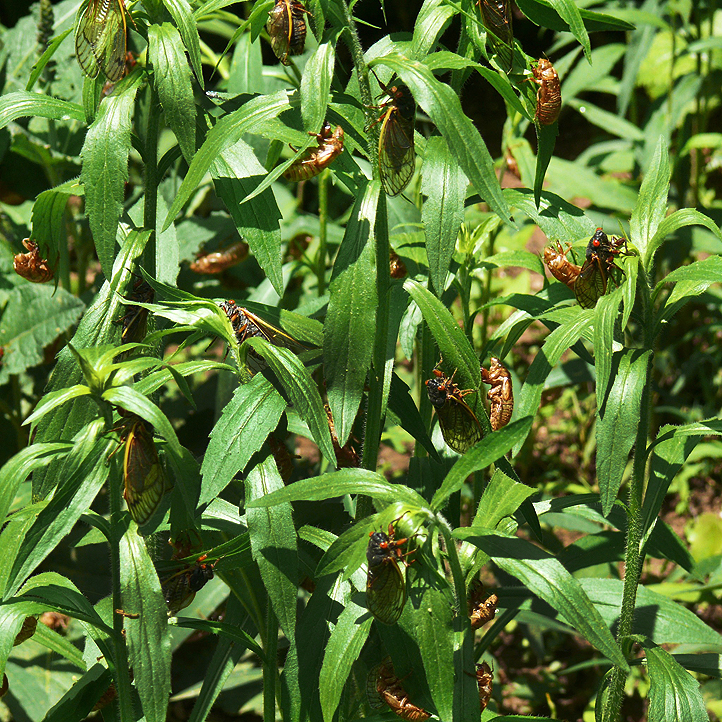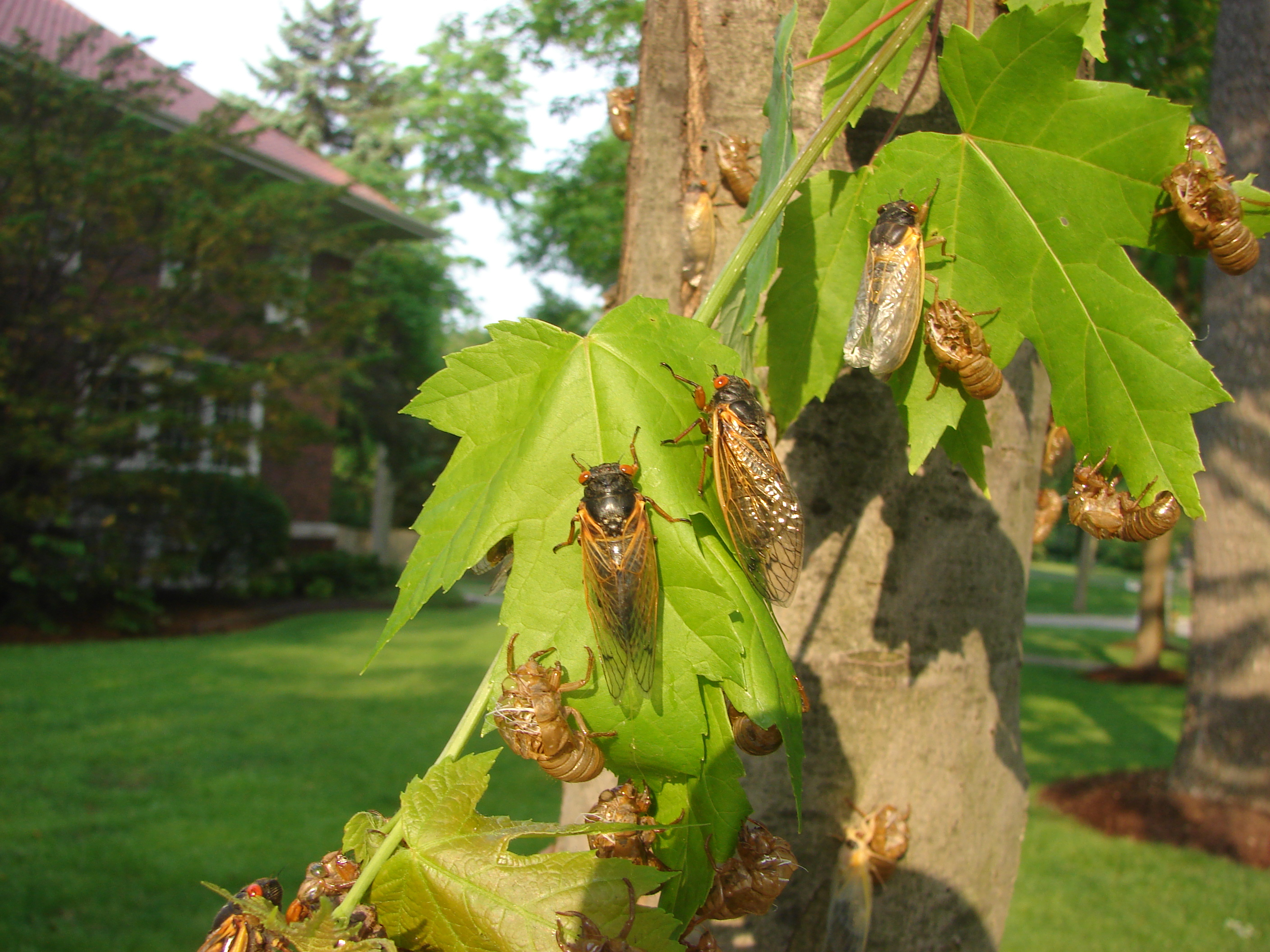Now that the solar eclipse in Illinois is behind us, it's time to look forward to the next rare phenomenon of 2024: Cicadas.
According to experts, 13-year cicadas and 17-year cicadas -- also known as Brood XIX and Brood XIII -- will soon surface at the same time in Illinois. The unusual, synchronized emergence is set to bring "billions" of cicadas to the state.
"We're at the center of the explosion this year," Allen Lawrance, associate curator of entomology at the Peggy Notebaert Nature Museum in Chicago, said. "It's pretty rare to have two broods — one of 17-year cicadas, one of 13-year cicadas — emerging at the same time in an area where they overlap a little bit."
Brood XIII will emerge "all across Northern Illinois," while Brood XIX will be in the southern part of the state, Lawrance said, with some parts of the state seeing both.
Feeling out of the loop? We'll catch you up on the Chicago news you need to know. Sign up for the weekly Chicago Catch-Up newsletter here.
And they're set to arrive sooner than you may expect.
When will cicadas emerge?
Cicadas typically emerge in mid-to-late May and into June, as the ground begins to warm in the spring and early summer. A post from the National Weather Service said the emergence can often depend on soil temperature.
"Research shows that the particular night of the periodical cicadas’ emergence depends on soil temperature," the post read. "Cicada juveniles, or nymphs, emerge after a rainstorm when the soil temperature at 8 inches in depth exceeds approximately 64°F."
Climate change can also affect the timing and emergence. According to the NWS, climate change impacted a cicada emergence in 2017, when Washington D.C. saw "a partial emergence of Brood X a full four years earlier."
In theory, warmer temperatures in Illinois leading up to summer could result in an earlier emergence, but "we'll have to wait and see," Lawrance said.
"Insects are cold blooded," he said. "They develop quicker when it's warmer and they develop slower when it's cold."
MORE: Do cicadas bite or sting? ‘Billions' of cicadas soon emerging in Illinois are ‘really chill'
Chicago officials issued an advisory last week, saying the first emergence is expected sometime around late April through early June, but the city might not see as much of an impact.
That means an emergence is likely between mid-May and early June, though some could start as early as late April.
For the Chicago area, Brood XIII will be most seen in parts of northern Illinois and Indiana, and possibly even in Wisconsin and Ohio, in late May 2024, Dr. Gene Kritsky, dean of Behavioral and Natural Sciences at Mount St. Joseph University in Cincinnati said in a 2023 press release.
According to an article from the University of Illinois Urbana-Champaign Extension, the Northern Illinois Brood's emergence typically occurs in May and June, and lasts approximately four weeks.
"Adult cicadas will be active until mid- to late-June, but you will see evidence long after they are gone, including their wings, molts, and decomposing bodies," cicada expert Catherine Dana, an affiliate with the Illinois Natural History Survey, told NBC Chicago.
Where will the two broods be seen?
The Northern Illinois Brood, or Brood XIII, will be most seen in parts of northern Illinois and Indiana, and possibly even in Wisconsin, Iowa and parts of Ohio. This brood will be the most prominent in the Chicago area for the upcoming emergence, experts say. But distribution will be patchy.
"Not every neighborhood is going to be as dense with them as others," he said. "One area may be slightly more quiet, and you'll hear them in the distance. And then you go to the next neighborhood, and it's hoppin', and they're everywhere."
There is one determining factor, however: If they were there before, they'll be there again.
"So, which neighborhoods you would expect to find them in will depend on where they were last time they emerged," Lawrance said. "If the soil had been completely dug up and replaced due to construction, there may be fewer cicadas there. But if they were there last time, chances are, they'll still be there."
Meanwhile, Brood XIX, or the Great Southern Brood cicadas, have a more widespread population, covering parts of Missouri, Illinois, Louisiana, North Carolina, Virginia and Maryland.
"Brood XIX is arguably the largest (by geographic extent) of all periodical cicada broods, with records along the east coast from Maryland to Georgia and in the Midwest from Iowa to Oklahoma," the University of Connecticut reports. "Although 13- year cicadas are generally considered to have a southern distribution, the northernmost known record of this brood is in Chebanse, IL, roughly 75 miles from Chicago’s Loop."
While the two broods have different emergence regions, there could be some locations that see an overlap of both.
"Somewhere around Central Illinois, probably like around Springfield, is what some researchers are predicting we may see some overlap of these two ... different broods," Dana said. "It's not going to be a large area. But there will likely actually be some mating happening between these two broods, which is going to be really exciting."
What are the cicadas doing underground?
For the past 17 years, billions of cicadas from Brood XIII have been living underground, tapping into fluid from plant roots, Lawrance said. Once they emerge, they'll be around for between four and six weeks, Lawrance added.
How and when they emerge in such a harmonious way, though, is a bit of a puzzle.
"That's kind of a big mystery," Lawrance said. "How are they so synchronized to do this? At the same time? There seems to be something that's genetically or physiologically controlled, so they just know instinctually to do this."
And once they burrow up, there's "really no escaping them," Lawrance said, especially on and around trees, where "piles" of cicada shells can are expected after the insects have feasted on fluid from branches and woody shrubs.
"You're just going to see them sort of flying around, hanging out on trees, and you're going to hear them wherever you go," Lawrance said.
That is, until they die and get composted back into the ground. Or get eaten.
MORE: Will 2024 cicada explosion mean rise in cicada-killing wasps? Here's what experts say
"Everything eats them," Lawrance said. "The periodical cicadas' 'life strategy' is by emerging all at once. Everything that eats them can eat as many as they want, and there are still more than enough cicadas left behind to continue the population."
Periodical cicadas, Lawrance said, are a "petty tasty snack" to squirrels, birds or snakes. Dogs can eat them too, Lawrance added, in moderation.
"As far as insects go, they're very large and meaty," Lawrance said. "They have a lot of nutrients there."
What exactly are we supposed to do with them?
Not much, Lawrance said.
"You should definitely not try to remove them from an area with billions," he said, adding that they'll get composted back into the soil on their own.
"That's kind of the great role they play within our ecosystems, is they spend a lot of time concentrating nutrients from a really good food resource that is the xylem and plants," Lawrance said. "And then, when they emerge en mass, they return those nutrients to the soil in one big group."
Those nutrients could result in a "big boost" in plant growth over the next couple of years, Lawrance added.
"All the animals that are around when they emerge are going to be very full and happy," Lawrance said. "Plants are going to get a boost in fertilizer for a little bit..when we have extreme weather events, like a drought, that cicada emergence happens at the right time that can provide a really valuable food source when nutrients are very scarce."
According to Lawrance, those nutrients could also be used in home gardens.
"If you want to fertilize your garden, or save on fertilizer for your garden, you could just throw some piles of cicadas in there as they decompose," Lawrance said.
'There's no stopping them'
According to the Environmental Protection Agency, pesticides are "generally ineffective at keeping cicadas away."
"So many cicadas emerge at once that more will inevitably move in," the agency said. "Spraying also doesn’t make sense because cicadas are generally harmless. Applying pesticides to control cicadas may harm other organisms, including animals that eat cicadas."
With such a large number, there will be no where to run come June, Lawrance stressed.
"There's no stopping them. They're here. It's temporary, and there's really no escaping them," he said.




